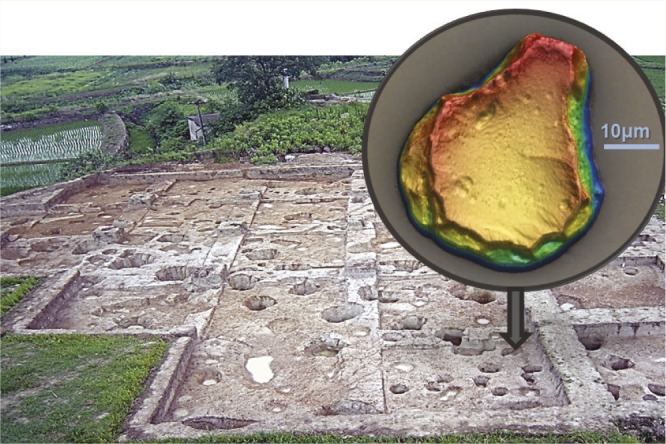Origin of rice domestication

3D image of rice bulliform phytolith from the Shangshan site.
Researchers have previously reported that microscopic bodies of silica, called phytoliths, from rice (Oryza saliva L.) found at the Shangshan site in the Lower Yangtze of China might represent the earliest example of rice cultivation. However, the age of the rice fossils was derived through radiocarbon dating of organic matter in pottery shards, which can be contaminated with older carbon sources. To constrain the age of the phytoliths, Houyuan Lu et al. (pp. 6486–6491) isolated rice phytoliths from carbon sources, such as clays and carbonate, and dated the phytoliths directly using radiocarbon dating. The authors validated the technique for directly dating phytoliths with radiocarbon ages of seeds and charcoal samples from the same stratigraphic layer at a nearby site called Huxi. The authors estimate that phytoliths retrieved from the early stages of the Shangshan and neighboring Hehuashan sites are approximately 9,400 and 9,000 years old, respectively. The morphology of specialized cells on the rice phytoliths indicate that the Shangshan rice specimens are more closely related to modern domesticated rice species than to wild rice species. According to the authors, rice domestication may have begun at Shangshan in the Lower Yangtze during the beginning of the Holocene. — L.C.
Reinterpreting quantum mechanics

Interference pattern from a double-slit experiment. Image courtesy of Wikimedia Commons/Timm Weitkamp.
According to traditional interpretations of quantum mechanics, elementary particles have wave-like properties described by a wave function. The physical meaning of the wave function has been a subject of considerable debate. Yakir Aharonov et al. (pp. 6480–6485) propose an alternative, time-symmetric, and explicitly nonlocal interpretation of quantum mechanics. In this interpretation, the wave function represents a property of a large ensemble of particles, not of a single particle. Properties of individual particles are represented by deterministic operators, the measurements of which do not disturb each other and have predictable outcomes. These operators can vary with time, while the wave function remains constant. According to this framework, in certain cases, the values of the operators, and hence the particle dynamics, can depend on potentials not only at the particle’s position but also at remote locations. Thus, in the classic double-slit experiment, a particle will be affected by both slits, even if the particle passes through only one of the two slits. In the authors’ interpretation, these nonlocal dynamics give rise to the interference observed in the classic double-slit experiment with a single particle. An uncertainty principle follows from this interpretation, implying that information about nonlocal potentials is lost once the particle’s position is determined, according to the authors. — B.D.
Child health and the International Monetary Fund

Across developing countries, lack of maternal education is associated with increased likelihood of death at a young age. Image courtesy of Pixabay/Fifaliana.
Systematic analyses of the impact of International Monetary Fund (IMF) structural adjustment programs on child health using microdata are lacking. Adel Daoud et al. (pp. 6492–6497) hypothesized that austerity measures mandated by the IMF as conditions for receiving loans might affect parents’ ability to protect children’s health. To test the hypothesis, the authors analyzed country, household, and child-level data representing around 2.8 billion people, or 50% of the world’s population in the year 2000. Child health was assessed across five dimensions: access to sanitation, clean water, health care, safe housing, and sufficient nutrition. The authors failed to find significant direct associations between IMF programs and child health indicators, but did find an association between IMF programs and the effect of parental education on child health. Having an educated head of household reduced a child’s odds of being deprived in any of the health metrics examined. In rural populations, the size of the protective effect on access to shelter, sanitation, nutrition, and health care was reduced in countries participating in IMF programs, but the effect on water access increased. In urban populations, the effect of parental education on access to shelter and sanitation increased in countries with IMF programs, but the effect on nutrition and health care decreased, according to the authors. — B.D.
Histamine and pathological grooming
Histamine, an immune regulator and neurotransmitter found in the nervous system, has been implicated in tic disorders and obsessive-compulsive disorder (OCD). Previous studies have found that mice with a mutation in a gene for histamine synthesis exhibit pathological repetitive behaviors such as excessive grooming. However, the role of histamine deficiency in the underlying brain processes as well as the precise location and developmental timing of disease-related changes remain unclear. Nor is the relevance of brain-localized versus peripheral histamine to the underlying disease processes established. Maximiliano Rapanelli et al. (pp. 6599–6604) report that mice in which histamine-producing neurons in the brain’s hypothalamus were depleted or silenced, while leaving peripheral histamine production intact, exhibited increased grooming. The effect was associated with increased neuronal activity in the dorsal striatum, a brain region previously associated with tic disorders and OCD. Infusing histamine into the striatum impeded increased grooming, whereas experimentally activating histamine-regulated neurons in the striatum boosted grooming. By contrast, activating histamine-regulated neurons in a different brain region, the medial prefrontal cortex, led to increased locomotion but not grooming, underscoring the specificity of the striatal effects. According to the authors, the findings might pave the way toward treatments for a range of disorders marked by repetitive behaviors, including Tourette syndrome, OCD, and autism. — P.N.
Age-related bias and NIH grants

NIH Clinical Research Center. Image courtesy of NIH.
Since 1980, a steady increase in the age of the youngest recipients of National Institutes of Health (NIH) R01 grants has suggested an age-related bias in the award of the grants. Using data on the age profiles and number of R01 grantees from NIH databases, Michael Levitt and Jonathan Levitt (pp. 6498–6503) found a decline in the number of basic science principal investigators (PIs) who were younger than 46 years and eligible to receive an R01 grant during the period from 1982 to 2014, a time span marked by a tripling in Congressional funds for the NIH. The fraction of basic science PIs who received R01 grants, a measure termed the PI success ratio, decreased for PIs younger than 46 years and increased for PIs older than 55 years during the same period. Between 1980 and 2014, the number of younger R01 grantees and basic science PIs fell by 34.2% and 25.6%, respectively, while the number of older R01 grantees increased threefold between 2001 and 2014. Further, the authors report that an NIH policy implemented in 2008 to proactively increase the success ratio of younger PIs has been largely effective. Age-related corrections based on the PI success ratio could help further strengthen the policy and counter intrinsic bias, the authors note. The future of US biomedical research depends on increasing the number of young PIs, according to the authors. — R.W.


